The Giants have started the season in probably the worst possible way they had envisioned. First, they suffered a loss in Dallas in which they outplayed the Cowboys in every way, except for giving away touchdowns and not executing in the red zone. Against the Broncos, they were able to hang on early, but turnovers showed up again, their level of play dropped, and the game ended up becoming basically a blowout.
The questions I keep seeing come up are of this nature: The Giants have this tremendous passing game, due to their three WRs and a good pass catching TE, so why are the problems David Wilson is having even important? (The Brandon Jacobs signing actually made Giant fans happy, when just an offseason before, many were happy to see him go.) With the run game troubles the Giants have had early on, some fans are even asking for the Giants to become like the Detroit Lions of 2011-2012 and have Eli drop back 50 times a game. With the way they can pass, why does the running game matter?
I am not here to talk about play-calling. (For what it’s worth, I think play-calling is by far the most overrated aspect of a team’s success or failure, and blaming performance on play-calling is a cop out for poor execution.) What I do want to go over is the question: What does the Giants play-action do for their offense? And if the Giants become a team that drops back 50+ times a game, what issues could arise from that?
I want to start this off by saying that, after watching the David Wilson carries, I’m very impressed with what he brings. Yes, I know the ball has ended up on the ground with him, and fumbles are deadly, as field position doesn’t even shift on a fumble (like it slightly does on an interception). But Wilson reads holes extremely well, and in the Denver game he showed that he can pass block and get out in the field. I almost want to throw out the Cowboys game from my analysis, because you can clearly see his head was not in the game at even the start of the 2nd quarter. But I won’t do that, because in the NFL you can’t just pick and choose when you want to play. With a player like Wilson, though, who is young and has potential, it is very important to his future prospects to show some flashes of very good-to-elite play and of being able to do the little things like pass block or run a play fake.
OK, let’s look at the tape:
Here we see the Cowboys’ newly installed 4-3 defense. On the top of the image, we see our squat press corner. We have 7 guys in the box, and on the bottom of the screen, we see the off-man corner. Though Monte loves his Tampa-2, he does have some talent at the CB position, so he can be a bit more free in his play calling. And over the top, we see our 2-deep safeties. This play occurs in the 3rd quarter of the game.
From the Giants perspective, let’s look at the RG and TE in particular. The right guard is pulling left, and the Giants keep TE Brandon Myers in a blocking set. Nothing too out of the ordinary here, if this is your typical run play.
Note: LBs are 4 yards off the ball.
So let’s look a few steps ahead. Our RG is now wrapping around; Myers is engaging Ware. And our RB has just completed his play-fake with Eli. Two things stand out here. The OLB on the bottom seems to be squaring up, meaning he has recognized the pass and is getting ready to either engage or turn his hips and run. But our 2 LBs in the middle have been fooled completely. They have attacked the line of scrimmage. Now, this defense could be a pure man coverage, in which case the LBs would be OK to blitz-engage into this, as the TE and RB they are assigned to have stayed in to block. But neither LB is really paying attention to the TE, and Myers could have easily chip-blocked/handed off the defender to his LT (William Beatty) and gone out for a quick stop route, and nobody would have been there to cover him. Maybe this is just terrific scouting by the Cowboys, but it’s much more likely that the Cowboys are overcompensating for the Giants rush game.
So what happens after that point? Well, the Cowboys actually were in a zone coverage. The LBs recognize the pass too late and have to rally to make it into their hook-to-curl zones. Look at our top LB in between the hashes: that is our dead giveaway that this is zone coverage, as otherwise there would be no reason for him to be there. But what happens when a team is caught attacking the rush game is that a zone can end up accidentally vacated, as the player gets “lost” instead of being in coverage. The Cowboys were in a cover-3-type look where the CBs crashed to their outside deep thirds, a safety covered the middle deep third, while the other safety is over the top, specifically looking at the far side WR. We do not get our LB set to cover the flat out to his zone, due to the confusion of the run, and so we end up with a WR sitting in a zone where he does not have a defender within 10 yards of him. That should never happen on a football field, but here we see the power of messing up coverages with something as simple as a play action pass.
Just for reference, here are the Cowboys in a very similar defense where the Giants do not show a play action:
Keeping defenses off guard can be very important as well. Grabbing a 6-7 yard gain based purely off of LBs being passive or confused is a great way to keep drives moving.
On this play, the Cowboys LBs get caught being passive and are engaged at only a yard up from their initial depth. They all get covered up, and Wilson is able to burst through the front seven for a large gain.
Below, we have some further slides. Here is what a pocket can become, and what the LB movement that the Giants want will look like, with the PA pass:
Our 4th DL for the Cowboys is off screen to the right in his wide 9 technique. From left to right on the defensive line, we have a 5 tech, a 2i/1 tech sitting in the A gap of the weak side and a 3 technique to the strong side. Our left inside backer in this nickel look is stacking our 2i, while our front side LB is sitting in C gap. likely with eyes on TE Brandon Myers post-snap.
So what do the Giants do? Well, Chris Snee is one of the most athletic and punishing guards in football. His is pulling from his RG position, circled here. We see a double team on that front side on #97; this looks like it will be a double team up to #54, to also take him out and a seam for the RB. Meanwhile, Snee will be locking up and kicking out #50. Could this be the makings of a big run play?
Now, note where the LBs are for the Cowboys. They are stuck at the line of scrimmage engaging a LG, LT, and a RG, with Wilson there as well. Hell, the run game even brought a safety into the box (#42). The potential for a big play out of the pass game increases with #42 in the picture; the middle of the field is now wide open.
Now what about when a team doesn’t respect the run game at all?
This is the first play of the game. The Giants are showing run immediately. It’s a play action pass. The LB’s play this extremely smart on this play. The safety over the top to this side is looking a bit too much into the backfield– he actually stutter-steps on this at the play fake instead of continuing to play the pass. Denver is in a quarters defense to start the game, though, so the deep pass play that goes over his head would have happened either way: the Giants recognized this quarters coverage and attack that safety with their TE, leaving a true one-on-one with Cruz against the Denver DB. But overall, the Giants want to move the LBs, as keeping those guys guessing can open up their run game as much as their passing game.
This is another play action pass that takes full advantage of the Denver LBs over-committing, as the WR is running an in route and the DB does not have that interior help he would otherwise have.
Now to answer some questions I know some of you will have. Am I suggesting to run the ball more than passing? Not at all. I’m not a believer in firm ratios– “pretend percentages” that must be followed to be optimal– an OC should call a game the way he sees it going, with the most effective plays for any situation. With that said, passing does gain more yards per play more than rushing, so it would obviously make sense to pass more, especially as the NFL has a number of ways an offense can gain a first down through penalty on a passing play. An offense that is unbalanced will, I feel, give the defense an unfair advantage. Allowing a defense to comfortably sit in a dime package or a nickel package is hurting your offense.
As an offense, you want to force linebackers on the field so that your QB can have advantages passing against their more limited coverage abilities. The other step you want to accomplish is to move the LBs around and get them out of position. As you’ve seen, that means having LBs attack the line when they shouldn’t, or getting them to sit back passively when you are handing the ball off. Keeping a defense off balance can lead to big plays both running and passing, and you won’t keep them off-balance by throwing 60 times a game. Of course, success can come from pure passing, and much more so than pure running. I am just a believer that successful teams find ways to keep the defense’s LBs looking in the wrong places. The Ravens had a lot of success in the playoffs doing this. The 49ers added other elements such as option reads into their offense to keep the defense even more off-balance. Not for nothing, they were your Super Bowl winner and runner-up. The Texans have had a run of success basing their offense off of zone runs and zone play-actions. I think Peyton Manning even appreciated playing with guys like Marshall Faulk and Edgerrin James all those years, for the same reasons. At least, he appreciated them much more than, say, Donald Brown.
Last, I want to cover something that’s a personal favorite of mine, because I think the Giants are among the best at instituting very advanced blocking schemes. I also just want to give the much-maligned David Wilson some credit.
This play is called as an inside trap. What makes it so different from your typical trap is that you get the “influence step” out of Snee, the RG. He’s circled in orange. What Snee is doing is making it look like he is attacking the DT, so the DT will want to engage him; after the initial step, Snee will cut inside and the DT will not be prepared to take on the pulling guard. So either the DT flies up field and gets flattened, or he is passive and can be pinned (“logged,” if you’re familiar with coaching terminology).
Here, we see the DT being passive, and Snee has completely cut off the hole. Now the guard circled in yellow can do what’s easiest for him– either kick out the DT or log him. The Giants have set up a terrific run play here, as the RT is making a seal-off block, while Myers, the TE, is already up at the second level. Snee and the center have the responsibility of the interior DT and that LB we see in the middle top of the picture.
Our pulling guard ends up logging the DT, the seal off block is successful, and Myers has engaged the LB. Sometimes being a running back really isn’t hard.

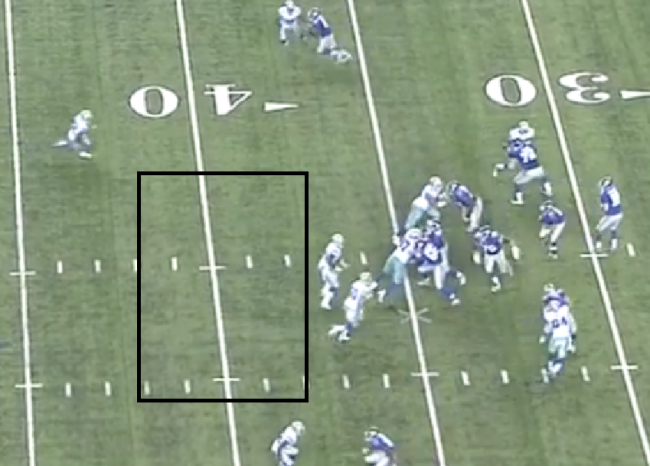
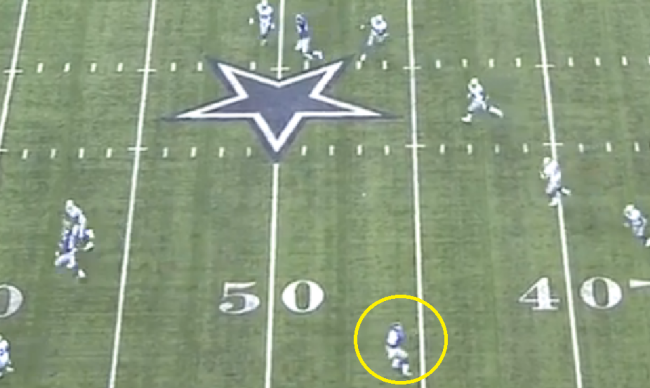

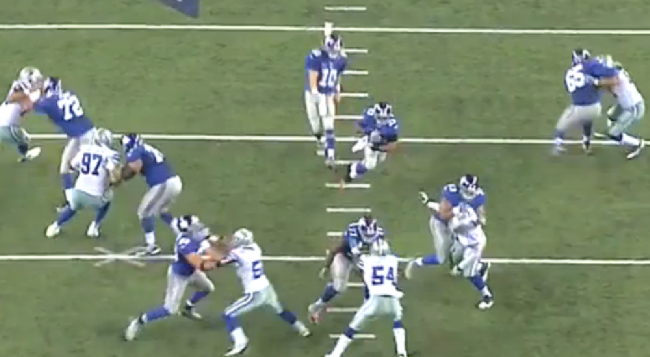

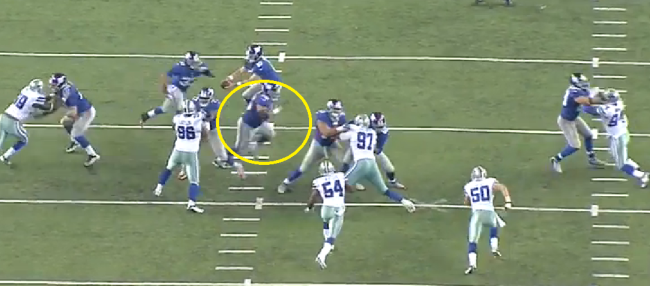

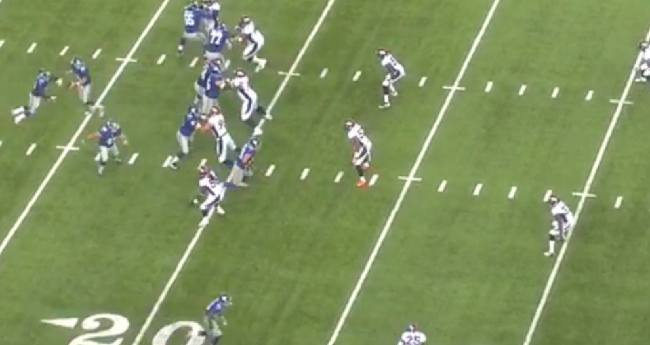
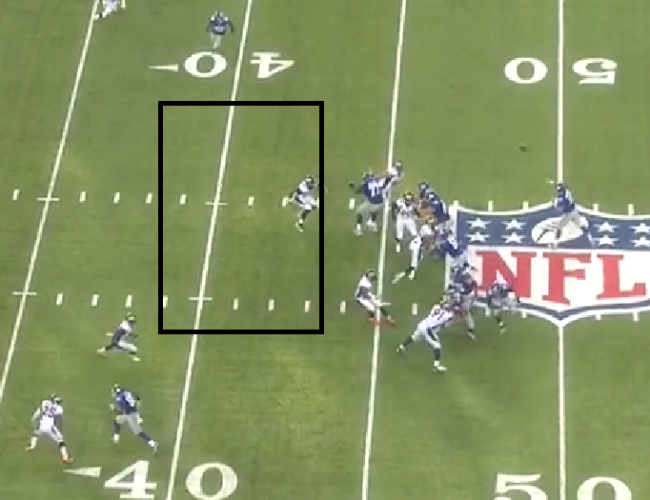

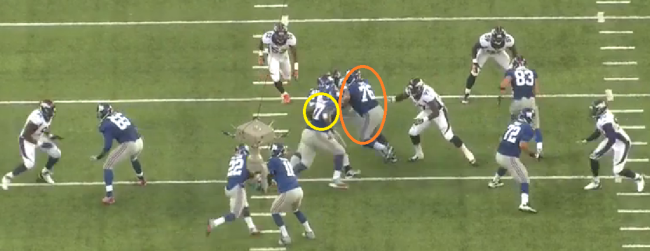

Love this work, really good. Can you do one on the Chiefs offense and explain the West Coast System?
We’ll see if we can. I know a post is coming up on the Chiefs’ defense.
YES